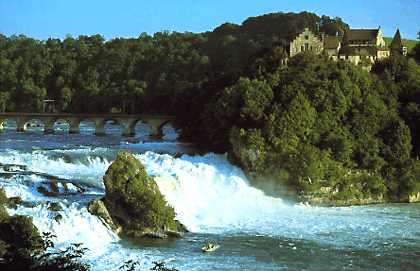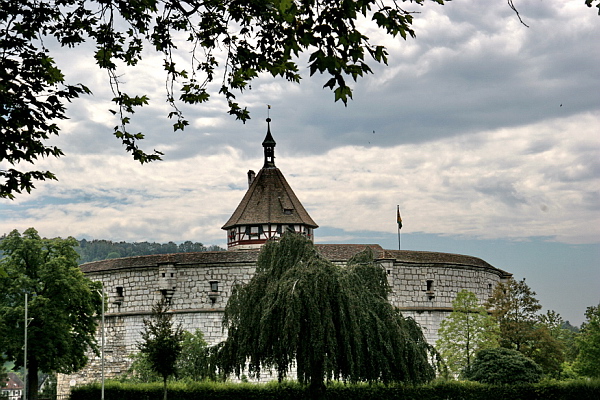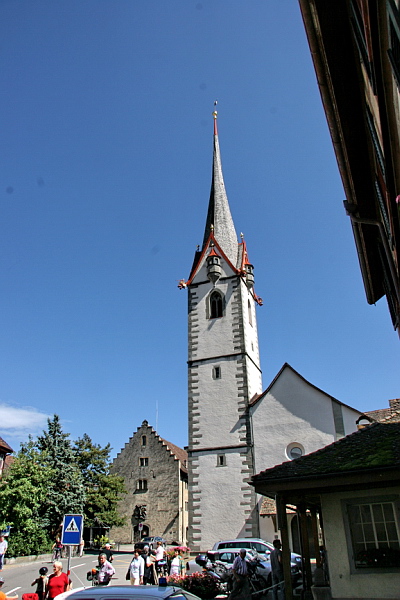Along Rhine
The Rhine Falls

The Rhine Falls, the largest Falls in Europe, offer a spectacular showpiece to visitors. With an average flow of 25’000 cubic ft / sec (700 m3 / sec) the water cascades down the cataracts, which are 450 ft ( 150 m) wide and 75 ft (23 m) high. Taking a boat trip into the basin below the cataracts you can feel the great power of the rushing water.
A boat trip either to the famous rock in the middle of the Falls with a short walk to the top, or across the river below the Falls or down the Rhine River are most exciting events. Starting from the medieval castle ‘Schloss Laufen’ a path leads down alongside the splashing water onto the lookout Kanzeli enabling the visitor a breathtaking contact with the Falls.
The Munot

This is Schaffhausen’s trademark circular fortress, built by forced labour in 1564 after the religious wars of the Reformation. The interior is dark and gloomy, with massive stone vaulting strong enough to support the 40,000-tonne superstructure. An internal spiral ramp – one of only three such designs in Europe – brings you out onto the circular roof of the bastion, with good views over the town. A different door exits onto stairs running through the vines planted on the Munot hill, down to the small riverside quarter known as Unterstadt; Schaffhausen’s annual Old Town shindig, held on a weekend in late June, still passes on alternate years between the salt-of-the-earth folk of the Unterstadt and their toffee-nosed neighbours of the town centre further west.

Visiting Stein-am-Rhein
The best way to arrive at Stein-am-Rhein is by boat. If you head east along the Schifflandi quay, and then cut north on tiny Schwarzhorngasse, you’ll come in a minute’s stroll to the breathtaking Rathausplatz. This square at the heart of the village is often acclaimed as the most picturesque in the country, ringed by medieval half-timbered buildings vying with each other for the lavishness of their frescoes and the gracefulness of their oriels. Standing alone at the head of the square is the Rathaus, built in 1539–42: the half-timbered top storeys are original, the middle floor dates from a 1745 renovation, and the ground floor facade and entranceway were added in 1865. The line of facades along the south side of the square is dazzling, each one sporting a fresco illustrating the house name: from left to right are the Hirschen (stag); Krone (crown); Vordere Krone (foremost crown), sporting an especially lofty gable; Roter Ochsen (red ox), the town’s oldest tavern, with a Gothic facade; Steinerner Trauben (stony grapes); Sonne (sun), the oldest hotel in the village with new frescoes dating from 1900; and the Schwarzer Horn (black horn). Opposite, on the north side, are the Adler (eagle); and, most impressive of all, the Weisser Adler (white eagle), bedecked in the town’s oldest frescoes, a Holbein-esque series of Renaissance-style scenes painted in 1520–25.
Inevitably, the rest of the village pales in comparison, but there are plenty of picturesque narrow lanes and alleys to explore off to each side, ignored by most visitors who, after a quick circuit of Rathausplatz, content themselves with a five-minute glance at the main Understadt–Oberstadt street running through the square, and the quayside.
A manor house at Understadt 18, originally dating from 1279 but entirely renovated in 1819, has been converted into the Museum Lindwurm, with surprisingly interesting and informative displays outlining Stein-am-Rhein’s bourgeois and agricultural life in the nineteenth century. The desk keeps English translations of the extensive notes which are posted alongside each section. A great deal of work has been done in the museum to recreate the living conditions of the wealthy upper-class family who owned the house and the servants and farmworkers who also lived there. Walking through the cobbled stables, the Empire-style drawing room, and the spartan servants’ quarters under the eaves, feels like stepping back in time.